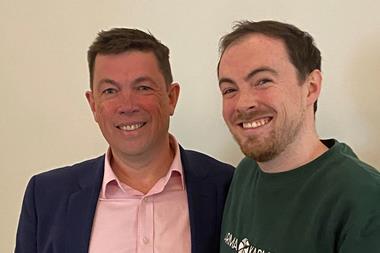The insurance industry must be a ‘force for good’ rather than ‘the naysayers we are sometimes seen as’, says broker boss
David Howden has long had ambitions to be a top player in reinsurance broking.
Now – with the Howden Group’s acquisition of reinsurance broker and risk management business TigerRisk Partners underway – his eponymous, ambitious, global business is finally in a position to take on the ‘Big Three’ of Gallagher Re, Willis Towers Watson (WTW) and Aon Re.
From a timing perspective, last year’s failed megamerger between Aon and WTW set the scene for the creation of a “much-needed fourth global player in the reinsurance market”, Howden notes.
The chief executive tells Insurance Times: “We’re obviously waiting for regulatory approval before we can formally complete the deal with TigerRisk, but the two companies are already working together and talking to clients about how we can deliver for them.
“For a long time now, [reinsurance broking] has been a three-horse race and currently, [Gallagher Re, Guy Carpenter and Aon Re] control 89% of the reinsurance business and it’s been a bit of a merry-go-round.
“Finally, there’s a really entrepreneurial, dynamic, data and capital market-driven ‘go for it’ business where the talent can come.
“We want to prove that we can really offer something different to our insurance and reinsurance clients and, therefore, offer something really fresh to the industry as a whole – and, ultimately, our clients.
“It is the final piece in our group’s architectural structure and it’s incredibly exciting what we’re going to be creating by the coming together of Howden and Tiger.”

Meeting of minds
Following the acquisition, the new Howden Tiger business will be led by Rob Bredahl as chief executive, alongside chairman Rod Fox and Howden Re’s Elliot Richardson as vice-chairman.
Howden Tiger will boast combined reinsurance revenues of $400m (£345m) and will employ around 450 reinsurance professionals across the world.
It will sit within the Howden Broking Group, alongside its capital markets business. This is quite deliberate, explains Howden, who aims to align these aspects of the business.
Having actual skin in the game has shaped both organisations’ approach.
“Tiger has a very similar DNA to us,” says Howden. “Many of the TigerRisk partners have equity in the business and to be blunt, they have built a business around the talent, around their expertise and ability to deliver. And that’s exactly what we’ve done.
“If you come up as the underdog and have to survive and thrive on your own merit, then you are properly entrepreneurial.”
TigerRisk was set up as a boutique reinsurance intermediary in 2008 following the merger of Aon and Benfield.
TigerRisk’s founder and executive chair Fox has always maintained the reinsurance broking ‘oligopoly’ is unsustainable.
Read: MGAs can help ‘keep insurance relevant’ – David Howden
Explore more broker-related content here.
“Tiger is about as entrepreneurial as you could possibly get,” says Howden. “Rod Fox set TigerRisk up because he really felt there was opportunity to build an independent reinsurance brokerage, which he did.
“To me, entrepreneurialism is building a business. Tiger and us have built businesses of real scale and real relevance by attracting really talented people and focusing on our clients and the coming together of Howden and Tiger is really exciting.”
Howden emphasised that the merger is “absolutely not” just “about a reinsurance play”.
He explains: “This is about how we bring together two very successful, highly entrepreneurial businesses to create a really new force. We’re looking at a combined business with around $13bn (£11.2bn) of premium where we’re delivering – in essence – end-to-end solutions to the ultimate client. And that’s what we must do.”
For Howden, the role of insurance in supporting economic development and offering solutions for businesses and society is what drives him.
He believes the industry can be a real “force for good” and that it has a purpose which is beyond profit. However, now is the time to really understand what is keeping corporate chief executives awake at night and devise solutions so brokers and underwriters are saying ‘yes’ more often than ‘no’.
“We need to sit down with our clients and just listen,” he continues.
“Find out what are the issues they are worried about and don’t talk about insurance at all. Instead ask ‘what would you want to get off your balance sheet to help you grow your business and can we help you mitigate that risk?’ Ultimately, can we bring in third party capital to allow you to move that off your balance sheet.
“Some of the best solutions that we’ve got now have come about when clients have talked to us about their issues and we’ve thought about it and said ‘actually, insurance is a solution for that’.
“Listening and innovating to provide solutions that are fit for purpose is one half of the equation.
“The other is accessing capital and capacity in order to provide meaningful limits. It’s one of the reasons that we brought on board Mary O’Connor in July 2022 to lead HowdenCAP, our new capital, advisory and placement business for financial institutions, investors and corporates.”
Read: Broker M&A hit record levels in 2021 – but how are the consolidators faring?
Explore more broker-related content here.
Distribution and capital
Providing capital markets solutions for insurance and reinsurance clients is an area that will grow substantially as Howden’s merger with TigerRisk completes.
Howden says: “We need to access capital in this market to remain relevant for our clients and that can be in the form of traditional capital, insurance company capital, insurance-linked securities capital, or even derivatives, which is another form of insurance.
“What has TigerRisk got? It has its absolutely outstanding capital markets business. We are going to have the number one capital market business that’s linked into a brokerage business.”
Howden is also a big proponent of the power of MGAs.
The company’s underwriting arm, Dual, has grown substantially – for example, in October 2021, it acquired US managing general agency Align Financial Holdings for $800m (£690m).
By also wrapping in Bowood, Howden Group’s specialist delegated binding authority division and one of the leading binding authority brokers to Lloyd’s, Howden Tiger will therefore have impressive programme, MGA and binding authority capability.
Pulling on Howden’s proprietary and wider network of MGAs is key to his vision for the business going forward - not just for the capital and distribution networks these companies provide, but also for the innovation that the market offers.
“For Howden Tiger, a lot of the expertise and premium is going to be coming [in] the form of MGAs,” he says. “About 25% of our combined revenue comes via our MGA business - not just through Dual, which is now writing [around] $3bn (£2.6bn) in premium, but via third party MGAs as well.
“What are MGAs really good at? They are really good at innovation. Many of the products that were created over the last 25 years have been created by MGAs.”
Howden points to the development of the cyber, renewable energy and hull war and indemnity market, among others, as examples.
“MGAs are absolutely critical to maintaining the relevance of our industry to our clients,” he continues.
“They’re great vehicles for non-traditional capacity to access the insurance market and for traditional insurance capacity to join forces to collectively cover risks they might not want to take on individually.”
Read: Howden Group aims to be new insurance industry ‘challenger’
Explore more broker-related content here.
Remaining relevant
The shocks of the past two to three years – or the ‘three Cs’ of conflict, climate change and Covid, as Howden calls it – have demonstrated the volatile risk landscape facing the industry and the demand from clients for solutions that protect them from this volatility.
For Howden, risks that are potentially systemic – such as cyber and pandemics – require significant capacity behind them, thoughtful wordings that will respect insurance’s ‘promise to pay’ and an ability to collaborate with the public sector where necessary.
Lessons must be learned from the Covid-19 crisis and litigation surrounding denied business interruption claims. Ultimately, clients want to be protected from outcomes, not risks, Howden says.
Commercial buyers do not relate to the traditional manner in which the insurance industry buckets its risks into classes of business or the annual renewal cycle.
He references aerospace organisation Airbus, which earlier this year announced that it had put aside a substantial $10bn (£8.6bn) cash reserve to insure itself against future crises and unforeseen losses.
This reflects badly on the industry regarding its ongoing relevance to clients, thinks Howden.
“As the world becomes more and more uncertain, we have got to create a long-term partnership with our clients to work out how we build resilience and help them retain value,” he says.
“It’s about the power of insurance to help provide answers and help businesses move risks off their balance sheets. If we’re not remaining relevant or thinking ‘the risks have changed and, therefore, we need to come up with new products’, then I do worry that the role of insurance is going to fade a bit.”
Read: David Howden proven to be ‘an extraordinary operator’ following Aston Lark acquisition
Explore more broker-related content here.
When it comes to major risks, such as those posed by climate change and cyber attacks, it is essential the industry collaborates to come up with meaningful risk mitigation and risk transfer solutions.
“We have to ensure there’s enough relevant capacity and enough risk transfer for our clients to see us as part of the solution and not the naysayers we are sometimes seen as,” says Howden.
“We’ve got to be very clear about our role and we’ve got to have a collective voice in coordinating being relevant and providing the coverage that our clients need. On climate change, we’re not there yet.”
From a reputational point of view, he worries there could be more bad press if policy exclusions are enforced when a major cyber incident occurs. “We could end up as an industry once again potentially not covering ourselves in glory,” he adds.
Underwriters might lack historical claims data when it comes to pricing and assessing new and emerging risks, but in an increasingly technological and data rich world, advanced analytics should provide some of the answers.
Even when underwriters do not have all the answers at their fingertips, the industry must be bold or it risks becoming irrelevant – this will become increasingly important as economies transition to net zero carbon dioxide emissions, Howden thinks.
He says: “One of the advantages we have now as an industry is that we are getting better data and we’re using that data, both to provide better outcomes for our clients and to understand risks better.
“Nevertheless, we’ve got to accept [that] as an industry, we are there – in some ways – to provide for the unknown, the unexpected.”
Rather than seeing insurtechs as a threat, Howden believes they have an essential role in helping the insurance industry transform and embrace the fourth industrial revolution.
“Markets need disrupting to give us all a bit of a kick up our own backsides, to make sure we actually stay relevant,” says Howden.
“Disruptors are good for us. I’ve been in the business for 40 years, building distribution, and ultimately, we need to make sure that we can link startups with funding, capacity and expertise in governance and systems all in one place, to hopefully accelerate the whole innovation process.”
- Insurance Times has converted dollar amounts into pounds using an exchange rate of £1 = $1.16, which was correct as of 1 September 2022.
Hosted by comedian and actor Tom Allen, 34 Gold, 23 Silver and 22 Bronze awards were handed out across an amazing 34 categories recognising brilliance and innovation right across the breadth of UK general insurance.



















































No comments yet